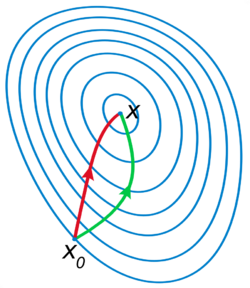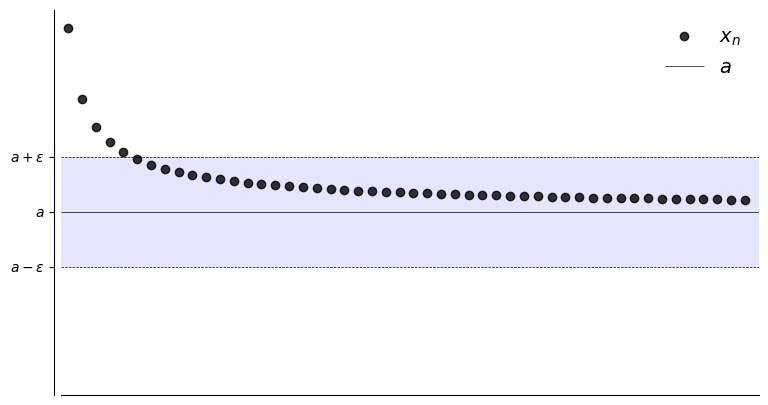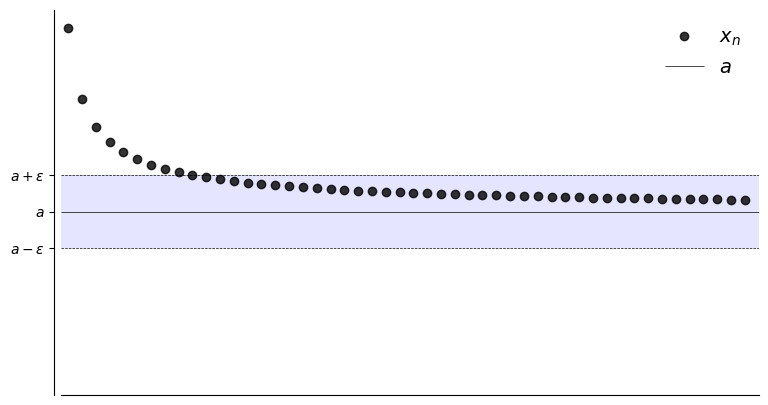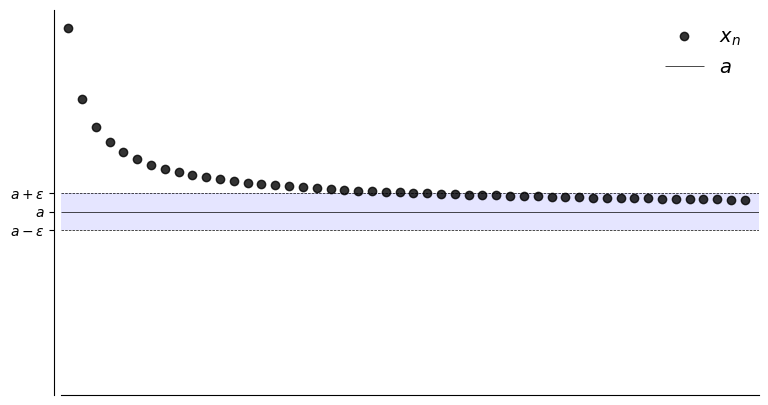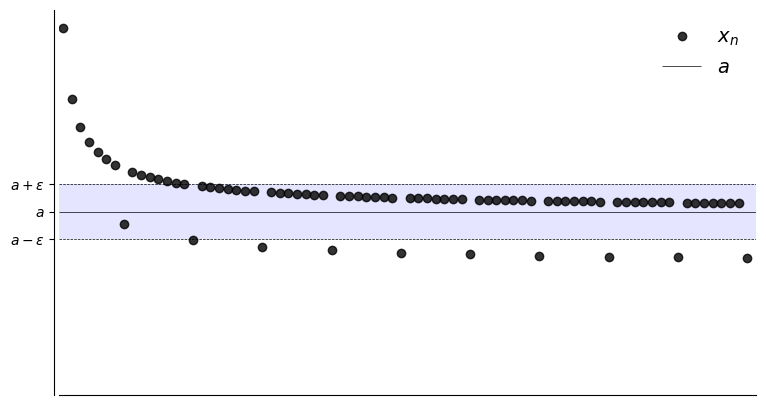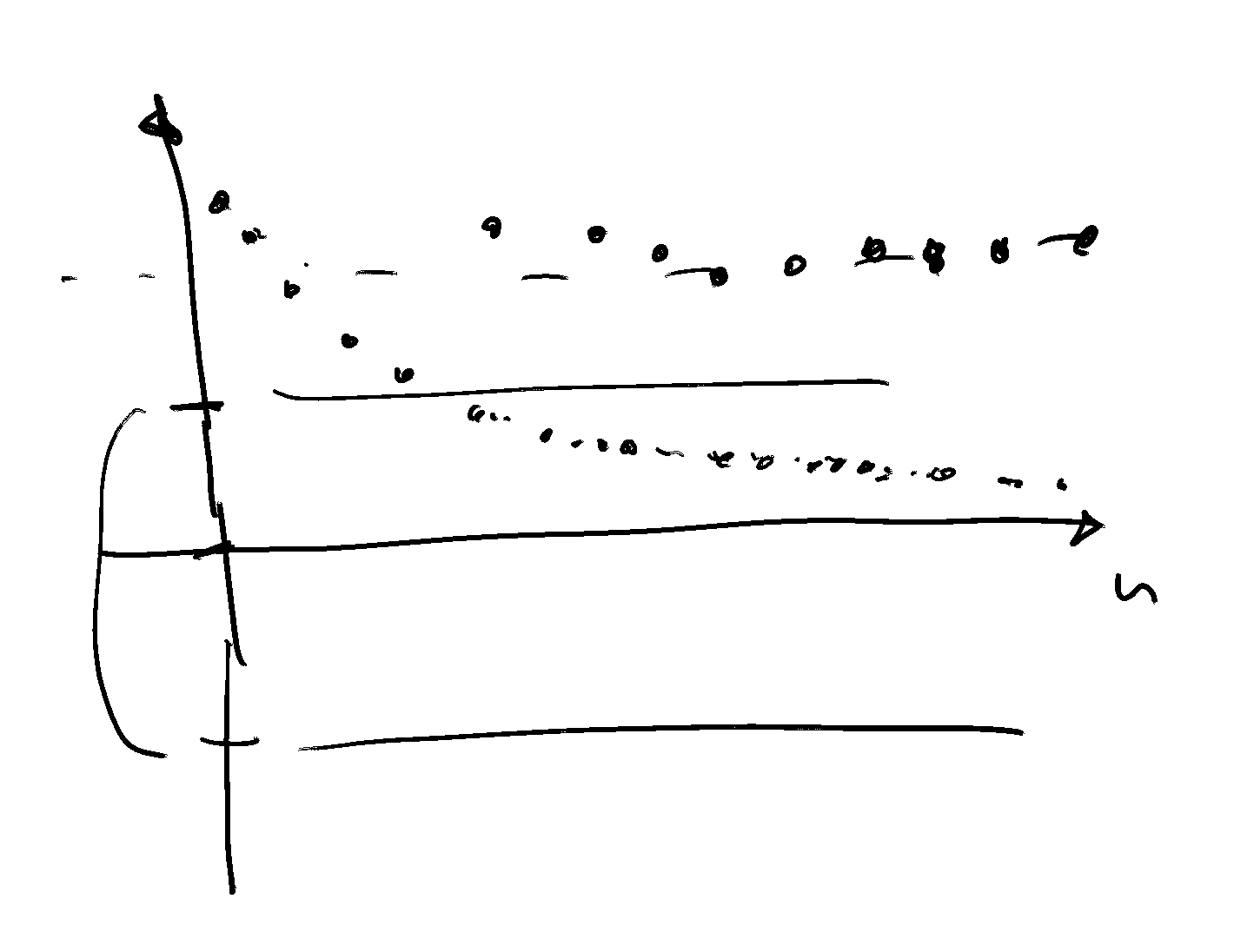Announcements & Reminders
Results of Online test 1
Orienteering at CBE on Wednesday March 13th, 12:00, behind CBE building. More information
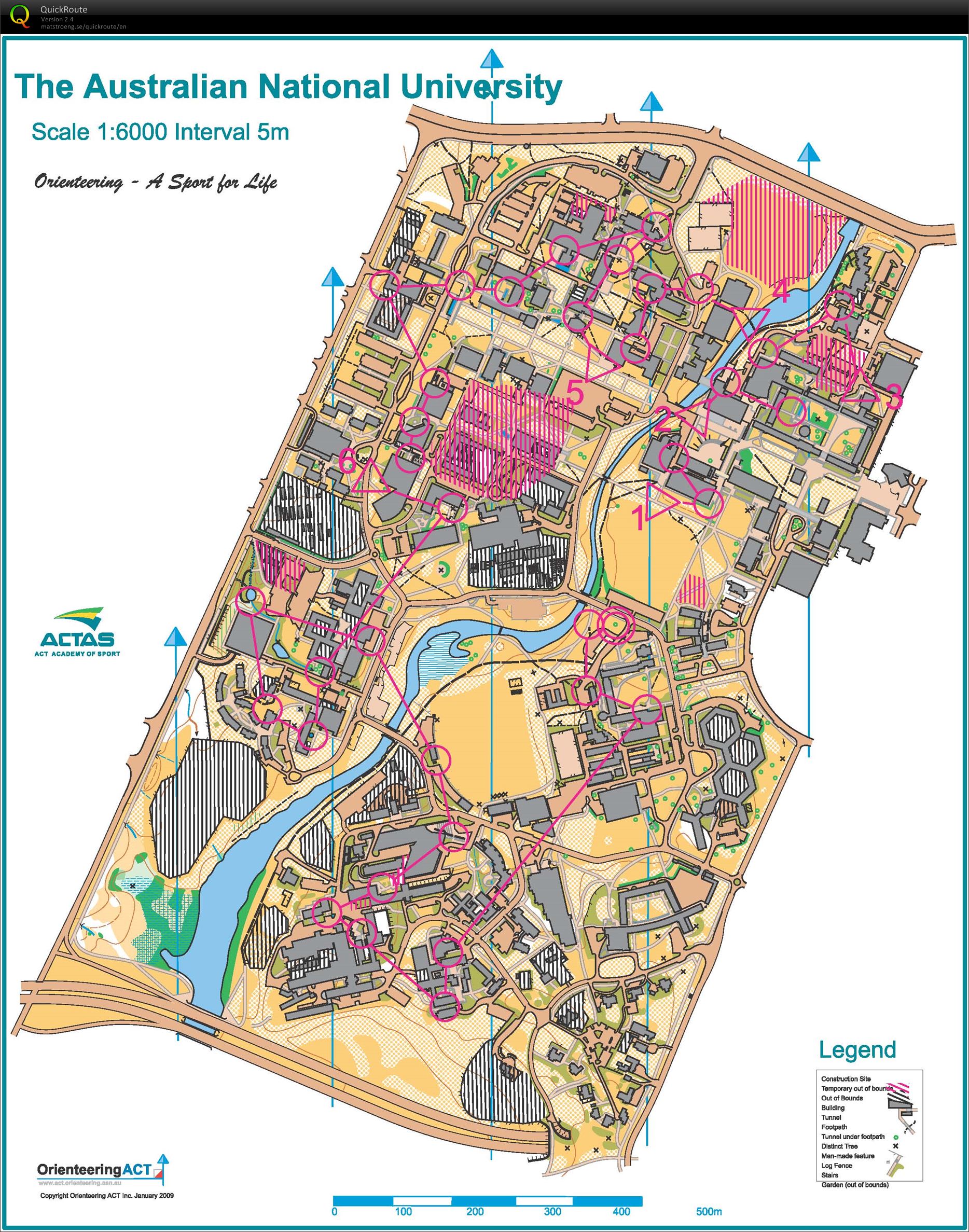
📖 Sequences, limits and continuity#
⏱ | words
Review of the basics of real analysis (mathematical analysis studies sequences, limit, continuity, differentiation, integration, etc.)
This lecture is on general theory of maxima and minima, and their existence.
we have to cover a lot of ground, mostly somewhat familiar
will work in \(\mathbb{R}^N\), the multidimensional space of real numbers 🤓
Plan:
Measuring distances in \(\mathbb{R}^N\) \(\rightarrow\) convergence
Bounded sets sets \(\rightarrow\) compact sets, existence of limits
Sequences \(\rightarrow\) convergence
Limits and convergences \(\rightarrow\) closedness
Open and closed sets \(\rightarrow\) compacts
Limits for functions \(\rightarrow\) continuity
Continuity of functions
Weierstrass extreme value theorem (continuous functions on compacts)
Note
Many textbooks use bold notation for vectors, but we do not. Typically it is explicitly stated that \(x \in \mathbb{R}^N\).
Norm and distance#
Definition
The (Euclidean) norm of \(x \in \mathbb{R}^N\) is defined as
Interpretation:
\(\| x \|\) represents the length of \(x\)
\(\| x - y \|\) represents distance between \(x\) and \(y\)

Fig. 31 Length of red line \(= \sqrt{x_1^2 + x_2^2} =: \|x\|\)#
\(\| x - y \|\) represents distance between \(x\) and \(y\)
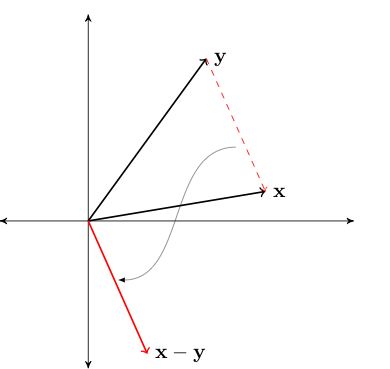
Fig. 32 Length of red line \(= \|x - y\|\)#
Fact
For any \(\alpha \in \mathbb{R}\) and any \(x, y \in \mathbb{R}^N\), the following statements are true:
\(\| x \| \geq 0\) and \(\| x \| = 0\) if and only if \(x = 0\)
\(\| \alpha x \| = |\alpha| \| x \|\)
Triangle inequality
\(\| x + y \| \leq \| x \| + \| y \|\)
Proof
For example, let’s show that \(\| x \| = 0 \iff x = 0\)
First let’s assume that \(\| x \| = 0\) and show \(x = 0\)
Since \(\| x \| = 0\) we have \(\| x \|^2 = 0\) and hence \(\sum_{n=1}^N x^2_n = 0\)
That is \(x_n = 0\) for all \(n\), or, equivalently, \(x = 0\)
Next let’s assume that \(x = 0\) and show \(\| x \| = 0\)
This is immediate from the definition of the norm
In fact, any function can be used as a norm, provided that the listed properties are satisfied
Example
More general distance function in \(\mathbb{R}\).

Fig. 33 Circle drawn with different norms#
Naturally, in \(\mathbb{R}\) Euclidean norm simplifies to
Show code cell source
import numpy as np
import matplotlib.pyplot as plt
def subplots():
"Custom subplots with axes throught the origin"
fig, ax = plt.subplots()
# Set the axes through the origin
for spine in ['left', 'bottom']:
ax.spines[spine].set_position('zero')
for spine in ['right', 'top']:
ax.spines[spine].set_color('none')
ax.grid()
return fig, ax
fig, ax = subplots()
ax.set_ylim(-3, 3)
ax.set_yticks((-3, -2, -1, 1, 2, 3))
x = np.linspace(-3, 3, 100)
ax.plot(x, np.abs(x), 'g-', lw=2, alpha=0.7, label=r'$f(x) = |x|$')
ax.plot(x, x, 'k--', lw=2, alpha=0.7, label=r'$f(x) = x$')
ax.legend(loc='lower right')
plt.show()
Therefore we can think of norm as a generalization of the absolute value to \(\mathbb{R}\)
Bounded sets#
Definition
A set \(A \subset \mathbb{R}^N\) called bounded if
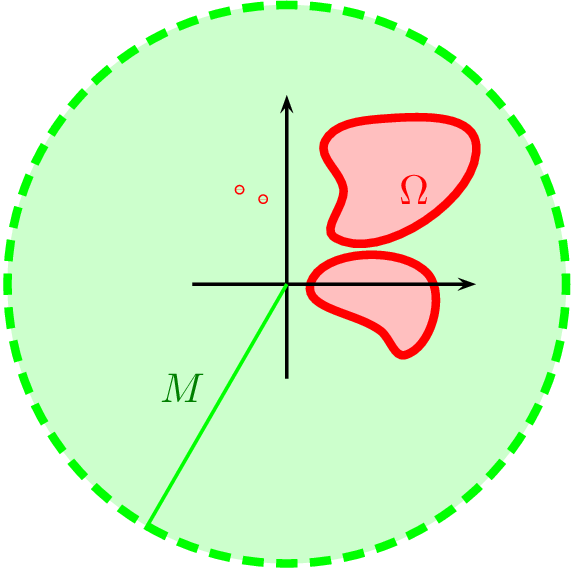
Fig. 34 Bounded set in \(\mathbb{R}^2\)#
Example
Every finite subset \(A\) of \(\mathbb{R}\) is bounded
Indeed, set \(M := \max \{ |a| : a \in A \}\). Then \(A\) is bounded by definition
Example
The set \(\{(x,y)\in\mathbb{R}^2\colon xy \leqslant 1 \}\) is unbounded
Proof:
For any \(M \in \mathbb{R}\) consider the point whit coordinates \(x=1/M\) and \(y=M\). This point belongs to the set because it satisfies \(xy=1\), yet
Therefore, for any candidate bound \(M\) we can find points in the set that are further away from the origin than \(M\).
Example
\((a, b)\) is bounded for any \(a, b \in \mathbb{R}\)
Proof:
Let \(M := \max\{ |a|, |b| \}\). We have to show that each \(x \in (a, b)\) satisfies \(|x| \leq M\)
Cases:
\(0 \le a \le b \implies x > 0, x = |x| < |b| = b = \max\{|a|,|b|\}\)
\(a \le b \le 0 \implies a < x < 0, |x|= -x < -a = |a| = \max\{|a|,|b|\}\)
\(a \le 0 \le b \implies\)
Fact
If \(A\) and \(B\) are bounded sets then so is \(A \cup B\)
Proof
Let \(A\) and \(B\) be bounded sets and let \(C := A \cup B\)
By definition, \(\exists \, M_A\) and \(M_B\) with
Let \(M_C := \max\{M_A , M_B\}\) and fix any \(x \in C\)
\(\epsilon\)-balls#
Definition
For \(\epsilon > 0\), the \(\epsilon\)-ball \(B_{\epsilon}(a)\) around \(a \in \mathbb{R}^N\) is all \(x \in \mathbb{R}^N\) such that \(\|a - x\| < \epsilon\)
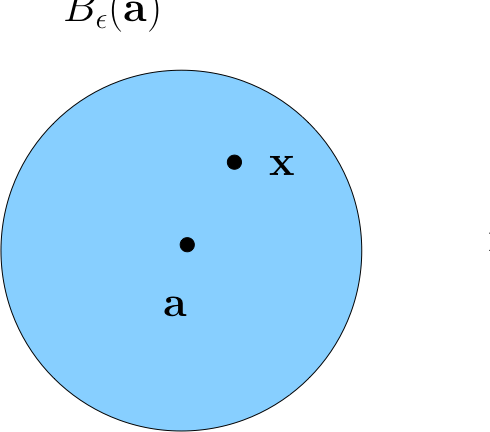
Correspondingly, in one dimension \(\mathbb{R}\)

Fact
If \(x\) is in every \(\epsilon\)-ball around \(a\) then \(x=a\)
Proof
Suppose to the contrary that
\(x\) is in every \(\epsilon\)-ball around \(a\) and yet \(x \ne a\)
Since \(x\) is not \(a\) we must have \(\|x-a\| > 0\)
Set \(\epsilon := \|x-a\|\)
Since \(\epsilon > 0\), we have \(x \in B_{\epsilon}(a)\)
This means that \(\|x-a\| < \epsilon\)
That is, \(\|x - a\| < \|x - a\|\)
Contradiction!
Fact
If \(a \ne b\), then \(\exists \; \epsilon > 0\) such that \(B_{\epsilon}(a)\) and \(B_{\epsilon}(b)\) are disjoint.

Proof
Let \(a, b \in \mathbb{R}^N\) with \(a \ne b\)
If we set \(\epsilon := \|a-b\|/2\), then \(B_{\epsilon}(a)\) and \(B_\epsilon(b)\) are disjoint
To see this, suppose to the contrary that \(\exists \, x \in B_{\epsilon}(a) \cap B_\epsilon(B)\)
Then \( \|x - a\| < \|a -b\|/2\) and \(\|x - b\| < \|a -b\|/2\)
But then
Contradiction!
Sequences#
Definition
A sequence \(\{x_n\}\) in \(\mathbb{R}^N\) is a function from \(\mathbb{N}\) to \(\mathbb{R}^N\)
To each \(n \in \mathbb{N}\) we associate one \(x_n \in \mathbb{R}^N\)
Typically written as \(\{x_n\}_{n=1}^{\infty}\) or \(\{x_n\}\) or \(\{x_1, x_2, x_3, \ldots\}\)
Example
In \(\mathbb{R}\)
\(\{x_n\} = \{2, 4, 6, \ldots \}\)
\(\{x_n\} = \{1, 1/2, 1/4, \ldots \}\)
\(\{x_n\} = \{1, -1, 1, -1, \ldots \}\)
\(\{x_n\} = \{0, 0, 0, \ldots \}\)
In \(\mathbb{R}^N\)
\(\{x_n\} = \big\{(2,..,2), (4,..,4), (6,..,6), \ldots \big\}\)
\(\{x_n\} = \big\{(1, 1/2), (1/2,1/4), (1/4,1/8), \ldots \big\}\)
Definition
Sequence \(\{x_n\}\) is called bounded if \(\{x_1, x_2, \ldots\}\) is a bounded set.
Example
Convergence and limit#
\(\mathbb{R}^1\)#
Let \(a \in \mathbb{R}\) and let \(\{x_n\}\) be a sequence
Suppose, for any \(\epsilon > 0\), we can find an \(N \in \mathbb{N}\) such that
alternatively for \(\mathbb{R}\)
Then \(\{x_n\}\) is said to converge to \(a\)
Convergence to \(a\) in symbols,
The sequence \(\{x_n\}\) is eventually in this \(\epsilon\)-ball around \(a\)
Show code cell source
import matplotlib.pyplot as plt
import numpy as np
# from matplotlib import rc
# rc('font',**{'family':'serif','serif':['Palatino']})
# rc('text', usetex=True)
def fx(n):
return 1 + 1/(n**(0.7))
def subplots(fs):
"Custom subplots with axes throught the origin"
fig, ax = plt.subplots(figsize=fs)
# Set the axes through the origin
for spine in ['left', 'bottom']:
ax.spines[spine].set_position('zero')
for spine in ['right', 'top']:
ax.spines[spine].set_color('none')
return fig, ax
def plot_seq(N,epsilon,a,fn):
fig, ax = subplots((9, 5))
xmin, xmax = 0.5, N+1
ax.set_xlim(xmin, xmax)
ax.set_ylim(0, 2.1)
n = np.arange(1, N+1)
ax.set_xticks([])
ax.plot(n, fn(n), 'ko', label=r'$x_n$', alpha=0.8)
ax.hlines(a, xmin, xmax, color='k', lw=0.5, label='$a$')
ax.hlines([a - epsilon, a + epsilon], xmin, xmax, color='k', lw=0.5, linestyles='dashed')
ax.fill_between((xmin, xmax), a - epsilon, a + epsilon, facecolor='blue', alpha=0.1)
ax.set_yticks((a - epsilon, a, a + epsilon))
ax.set_yticklabels((r'$a - \epsilon$', r'$a$', r'$a + \epsilon$'))
ax.legend(loc='upper right', frameon=False, fontsize=14)
plt.show()
N = 50
a = 1
plot_seq(N,0.30,a,fx)
plot_seq(N,0.20,a,fx)
plot_seq(N,0.10,a,fx)
Definition
The point \(a\) is called the limit of the sequence, denoted
if
Example
\(\{x_n\}\) defined by \(x_n = 1 + 1/n\) converges to \(1\):
To prove this we must show that \(\forall \, \epsilon > 0\), there is an \(N \in \mathbb{N}\) such that
To show this formally we need to come up with an “algorithm”
You give me any \(\epsilon > 0\)
I respond with an \(N\) such that equation above holds
In general, as \(\epsilon\) shrinks, \(N\) will have to grow
Proof:
Here’s how to do this for the case \(1 + 1/n\) converges to \(1\)
First pick an arbitrary \(\epsilon > 0\)
Now we have to come up with an \(N\) such that
Let \(N\) be the first integer greater than \( 1/\epsilon\)
Then
Remark: Any \(N' > N\) would also work
Example
The sequence \(x_n = 2^{-n}\) converges to \(0\) as \(n \to \infty\)
Proof:
Must show that, \(\forall \, \epsilon > 0\), \(\exists \, N \in \mathbb{N}\) such that
So pick any \(\epsilon > 0\), and observe that
Hence we take \(N\) to be the first integer greater than \(- \ln \epsilon / \ln 2\)
Then
What if we want to show that \(x_n \to a\) fails?
To show convergence fails we need to show the negation of
In words, there is an \(\epsilon > 0\) where we can’t find any such \(N\)
That is, for any choice of \(N\) there will be \(n>N\) such that \(x_n\) jumps to the outside \(B_{\epsilon}(a)\)
In other words, there exists a \(B_\epsilon(a)\) such that \(x_n \notin B_\epsilon(a)\) again and again as \(n \to \infty\).
This is the kind of picture we’re thinking of
Show code cell source
def fx2(n):
return 1 + 1/(n**(0.7)) - 0.3 * (n % 8 == 0)
N = 80
a = 1
plot_seq(N,0.15,a,fx2)
Example
The sequence \(x_n = (-1)^n\) does not converge to any \(a \in \mathbb{R}\)
Proof:
This is what we want to show
Since it’s a “there exists”, we need to come up with such an \(\epsilon\)
Let’s try \(\epsilon = 0.5\), so that
We have:
If \(n\) is odd then \(x_n = -1\) when \(n > N\) for any \(N\).
If \(n\) is even then \(x_n = 1\) when \(n > N\) for any \(N\).
Therefore even if \(a=1\) or \(a=-1\), \(\{x_n\}\) not in \(B_\epsilon(a)\) infinitely many times as \(n \to \infty\). It holds for all other values of \(a \in \mathbb{R}\).
\(\mathbb{R}^N\)#
Definition
Sequence \(\{x_n\}\) is said to converge to \(a \in \mathbb{R}^N\) if
We can say
\(\{x_n\}\) is eventually in any \(\epsilon\)-neighborhood of \(a\)
In this case \(a\) is called the limit of the sequence, and as in one-dimensional case, we write

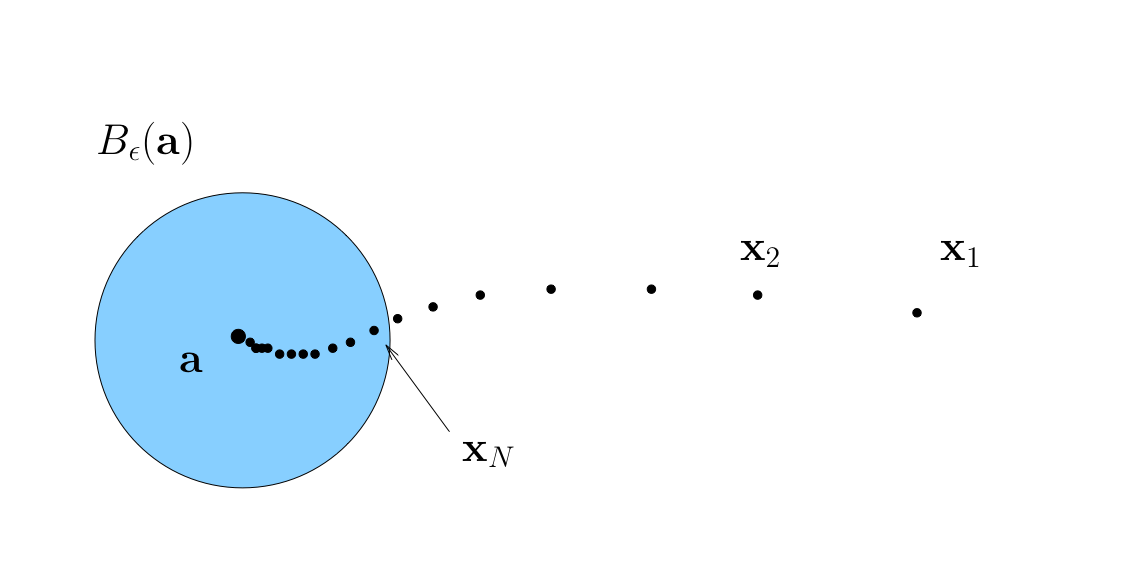
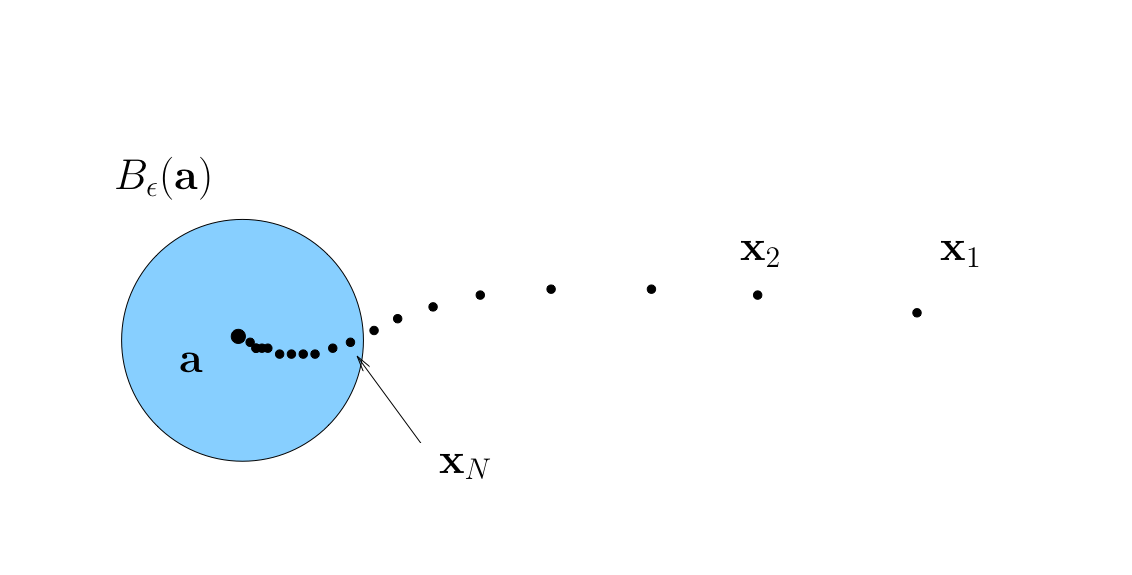
Definition
We call \(\{ x_n \}\) convergent if it converges to some limit in \(\mathbb{R}^N\)
Vector vs Componentwise Convergence#
Fact
A sequence \(\{x_n\}\) in \(\mathbb{R}^N\) converges to \(a \in \mathbb{R}^N\) if and only if each component sequence converges in \(\mathbb{R}\)
That is,
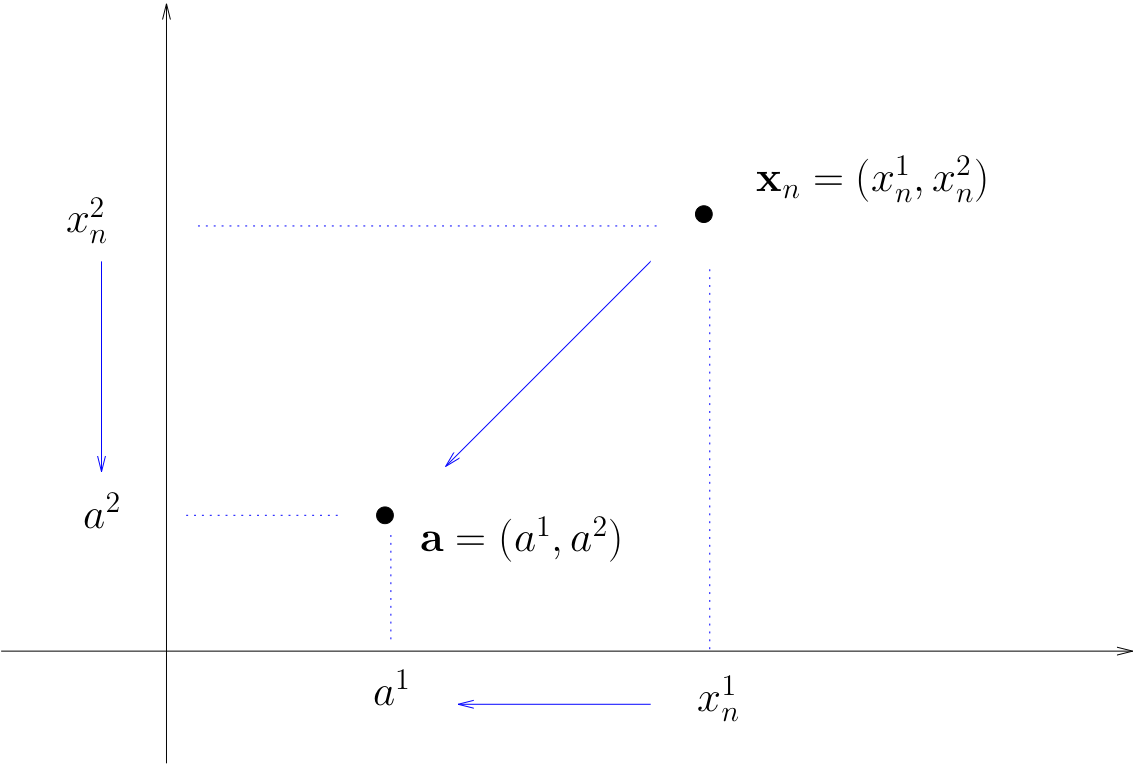
Proof
The sketch of the proof:
\(\Rightarrow\) (necessity): verify that the definition of convergence in \(\mathbb{R}\) corresponds to the convergence in each dimension by definition where \(\epsilon\)-neighborhoods are projection of the \(B_\epsilon(a)\)
\(\Leftarrow\) (sufficiency): verify that convergence in \(\mathbb{R}\) by definition follows from the definitions to the convergence in each dimension when the required \(B_\epsilon(a)\) ball is constructed to contain the hypercube of the \(\epsilon\)-neighborhoods of each dimension.
Properties of limit#
Fact
\(x_n \to a\) in \(\mathbb{R}^N\) if and only if \(\|x_n - a\| \to 0\) in \(\mathbb{R}\)
If \(x_n \to x\) and \(y_n \to y\) then \(x_n + y_n \to x + y\)
If \(x_n \to x\) and \(\alpha \in \mathbb{R}\) then \(\alpha x_n \to \alpha x\)
If \(x_n \to x\) and \(y_n \to y\) then \(x_n y_n \to xy\)
If \(x_n \to x\) and \(y_n \to y\) then \(x_n / y_n \to x/y\), provided \(y_n \ne 0\), \(y \ne 0\)
If \(x_n \to x\) then \(x_n^p \to x^p\)
Proof
Let’s prove that
\(x_n \to a\) in \(\mathbb{R}^N\) means that
\(\|x_n - a\| \to 0\) in \(\mathbb{R}\) means that
Obviously equivalent
Exercise: Prove other properties using definition of limit
Fact
Each sequence in \(\mathbb{R}^N\) has at most one limit
Proof
Proof for the \(\mathbb{R}\) case.
Suppose instead that \(x_n \to a \text{ and } x_n \to b \text{ with } a \ne b \)
Take disjoint \(\epsilon\)-balls around \(a\) and \(b\)

Since \(x_n \to a\) and \(x_n \to b\),
\(\exists \; N_a\) s.t. \(n \geq N_a \implies x_n \in B_{\epsilon}(a)\)
\(\exists \; N_b\) s.t. \(n \geq N_b \implies x_n \in B_{\epsilon}(b)\)
But then \(n \geq \max\{N_a, N_b\} \implies \) \(x_n \in B_{\epsilon}(a)\) and \(x_n \in B_{\epsilon}(b)\)
Contradiction, as the balls are assumed disjoint
Fact
Every convergent sequence is bounded
Proof
Proof for the \(\mathbb{R}\) case.
Let \(\{x_n\}\) be convergent with \(x_n \to a\)
Fix any \(\epsilon > 0\) and choose \(N\) s.t. \(x_n \in B_{\epsilon}(a)\) when \(n \geq N\)
Regarded as sets,
Both of these sets are bounded
First because finite sets are bounded
Second because \(B_{\epsilon}(a)\) is bounded
Further, finite unions of bounded sets are bounded
Cauchy sequences#
Informal definition: Cauchy sequences are those where \(|x_n - x_{n+1}|\) gets smaller and smaller

Example
Sequences generated by iterative methods for solving nonlinear equations often have this property
Show code cell source
f = lambda x: -4*x**3+5*x+1
g = lambda x: -12*x**2+5
def newton(fun,grad,x0,tol=1e-6,maxiter=100,callback=None):
'''Newton method for solving equation f(x)=0
with given tolerance and number of iterations.
Callback function is invoked at each iteration if given.
'''
for i in range(maxiter):
x1 = x0 - fun(x0)/grad(x0)
err = abs(x1-x0)
if callback != None: callback(err=err,x0=x0,x1=x1,iter=i)
if err<tol: break
x0 = x1
else:
raise RuntimeError('Failed to converge in %d iterations'%maxiter)
return (x0+x1)/2
def print_err(iter,err,**kwargs):
x = kwargs['x'] if 'x' in kwargs.keys() else kwargs['x0']
print('{:4d}: x = {:14.8f} diff = {:14.10f}'.format(iter,x,err))
print('Newton method')
res = newton(f,g,x0=123.45,callback=print_err,tol=1e-10)
Newton method
0: x = 123.45000000 diff = 41.1477443465
1: x = 82.30225565 diff = 27.4306976138
2: x = 54.87155804 diff = 18.2854286376
3: x = 36.58612940 diff = 12.1877193931
4: x = 24.39841001 diff = 8.1212701971
5: x = 16.27713981 diff = 5.4083058492
6: x = 10.86883396 diff = 3.5965889909
7: x = 7.27224497 diff = 2.3839931063
8: x = 4.88825187 diff = 1.5680338561
9: x = 3.32021801 diff = 1.0119341175
10: x = 2.30828389 diff = 0.6219125117
11: x = 1.68637138 diff = 0.3347943714
12: x = 1.35157701 diff = 0.1251775194
13: x = 1.22639949 diff = 0.0188751183
14: x = 1.20752437 diff = 0.0004173878
15: x = 1.20710698 diff = 0.0000002022
16: x = 1.20710678 diff = 0.0000000000
Definition
A sequence \(\{x_n\}\) is called Cauchy if
Alternatively
Cauchy sequences allow to establish convergence without finding the limit itself!
Fact
Every convergent sequence is Cauchy, and every Cauchy sequence is convergent.
Proof
Proof of \(\Rightarrow\):
Let \(\{x_n\}\) be a sequence converging to some \(a \in \mathbb{R}\)
Fix \(\epsilon > 0\)
We can choose \(N\) s.t.
For this \(N\) we have \(n \geq N\) and \(j \geq 1\) implies
Proof of \(\Leftarrow\):
Follows from the density property of \(\mathbb{R}\)
Example
\(\{x_n\}\) defined by \(x_n = \alpha^n\) where \(\alpha \in (0, 1)\) is Cauchy
Proof:
For any \(n , j\) we have
Fix \(\epsilon > 0\)
We can show that \(n > \log(\epsilon) / \log(\alpha) \implies \alpha^n < \epsilon\)
Hence any integer \(N > \log(\epsilon) / \log(\alpha)\) the sequence is Cauchy by definition.
Subsequences#
Definition
A sequence \(\{x_{n_k} \}\) is called a subsequence of \(\{x_n\}\) if
\(\{x_{n_k} \}\) is a subset of \(\{x_n\}\)
\(\{n_k\}\) is sequence of strictly increasing natural numbers
Example
In this case
Example
\(\{\frac{1}{1}, \frac{1}{3}, \frac{1}{5},\ldots\}\) is a subsequence of \(\{\frac{1}{1}, \frac{1}{2}, \frac{1}{3}, \ldots\}\)
\(\{\frac{1}{1}, \frac{1}{2}, \frac{1}{3},\ldots\}\) is a subsequence of \(\{\frac{1}{1}, \frac{1}{2}, \frac{1}{3}, \ldots\}\)
\(\{\frac{1}{2}, \frac{1}{2}, \frac{1}{2},\ldots\}\) is not a subsequence of \(\{\frac{1}{1}, \frac{1}{2}, \frac{1}{3}, \ldots\}\)
Fact
If \(\{ x_n \}\) converges to \(x\) in \(\mathbb{R}^N\), then every subsequence of \(\{x_n\}\) also converges to \(x\)
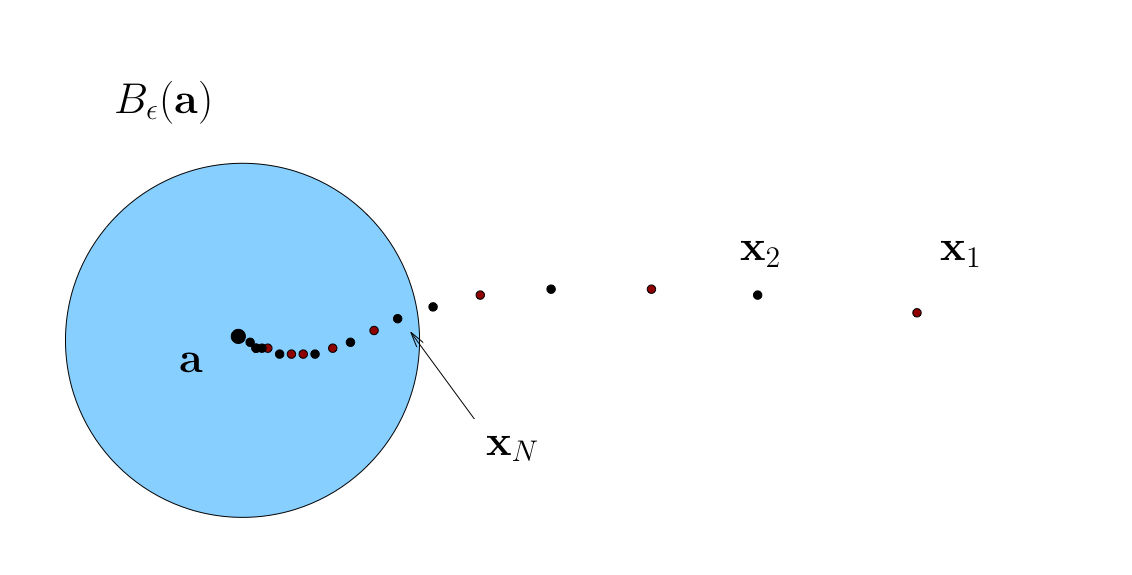
Fig. 35 Convergence of subsequences#
Bolzano-Weierstrass theorem#
This leads us to the famous theorem, which will be part of the proof of the central Weierstrass extreme values theorem, which provides conditions for existence of a maximum and minimum of a function.
Fact: Bolzano-Weierstrass theorem
Every bounded sequence in \(\mathbb{R}^N\) has a convergent subsequence
Proof
Omitted, but see Wiki and resources referenced there.
Open and closed sets#
Definition
Let \(G \subset \mathbb{R}^N\). We call \(x \in G\) interior to \(G\) if \(\exists \; \epsilon > 0\) with \(B_\epsilon(x) \subset G\)

Fig. 36 Loosely speaking, interior means “not on the boundary”#
Example
If \(G = (a, b)\) for some \(a < b\), then any \(x \in (a, b)\) is interior

Proof:
Fix any \(a < b\) and any \(x \in (a, b)\)
Let \(\epsilon := \min\{x - a, b - x\}\)
If \(y \in B_\epsilon(x)\) then \(y < b\) because
Exercise: Show \(y \in B_\epsilon(x) \implies y > a\)
Example
If \(G = [-1, 1]\), then \(1\) is not interior

Proof:
Intuitively, any \(\epsilon\)-ball centered on \(1\) will contain points \(> 1\)
More formally, pick any \(\epsilon > 0\) and consider \(B_\epsilon(1)\)
There exists a \(y \in B_\epsilon(1)\) such that \(y \notin [-1, 1]\)
For example, consider the point \(y := 1 + \epsilon/2\)
Exercise: Check this point: lies in \(B_\epsilon(1)\) but not in \([-1, 1]\)
Definition
A set \(G\subset \mathbb{R}^N\) is called open if all of its points are interior
Example
Open sets:
any open interval \((a,b) \subset \mathbb{R}\), since we showed all points are interior
any open ball \(B_\epsilon(a) = x \in \mathbb{R}^N : \|x - a \| < \epsilon\)
\(\mathbb{R}^N\) itself satisfies the defintion of open set
Sets that are not open
\((a,b]\) because \(b\) is not interior
\([a,b)\) because \(a\) is not interior
Closed Sets#
Definition
A set \(F \subset \mathbb{R}^N\) is called closed if every convergent sequence in \(F\) converges to a point in \(F\)
Rephrased: If \(\{x_n\} \subset F\) and \(x_n \to x\) for some \(x \in \mathbb{R}^N\), then \(x \in F\)
Example
All of \(\mathbb{R}^N\) is closed \(\Leftarrow\) every sequence converging to a point in \(\mathbb{R}^N\) converges to a point in \(\mathbb{R}^N\)!
Example
If \((-1, 1) \subset \mathbb{R}\) is not closed
Proof:
True because
\(x_n := 1-1/n\) is a sequence in \((-1, 1)\) converging to \(1\),
and yet \(1 \notin (-1, 1)\)
Example
If \(F = [a, b] \subset \mathbb{R}\) then \(F\) is closed in \(\mathbb{R}\)
Proof:
Take any sequence \(\{x_n\}\) such that
\(x_n \in F\) for all \(n\)
\(x_n \to x\) for some \(x \in \mathbb{R}\)
We claim that \(x \in F\)
Recall that (weak) inequalities are preserved under limits:
\(x_n \leq b\) for all \(n\) and \(x_n \to x\), so \(x \leq b\)
\(x_n \geq a\) for all \(n\) and \(x_n \to x\), so \(x \geq a\)
therefore \(x \in [a, b] =: F\)
Properties of Open and Closed Sets#
Fact
\(G \subset \mathbb{R}^N\) is open \(\iff \; G^c\) is closed
Proof
\(\implies\)
First prove necessity
Pick any \(G\) and let \(F := G^c\)
Suppose to the contrary that \(G\) is open but \(F\) is not closed, so
\(\exists\) a sequence \(\{x_n\} \subset F\) with limit \(x \notin F\)
Then \(x \in G\), and since \(G\) open, \(\exists \, \epsilon > 0\) such that \(B_\epsilon(x) \subset G\)
Since \(x_n \to x\) we can choose an \(N \in \mathbb{N}\) with \(x_N \in B_\epsilon(x)\)
This contradicts \(x_n \in F\) for all \(n\)
\(\Longleftarrow\)
Next prove sufficiency
Pick any closed \(F\) and let \(G := F^c\), need to prove that \(G\) is open
Suppose to the contrary that \(G\) is not open
Then exists some non-interior \(x \in G\), that is no \(\epsilon\)-ball around \(x\) lies entirely in \(G\)
Then it is possible to find a sequence \(\{x_n\}\) which converges to \(x \in G\), but every element of which lies in the \(B_{1/n}(x) \cap F\)
This contradicts the fact that \(F\) is closed
Fact
Any singleton \(\{ x \} \subset \mathbb{R}^N\) is closed
Proof
Let’s prove this by showing that \(\{x\}^c\) is open
Pick any \(y \in \{x\}^c\)
We claim that \(y\) is interior to \(\{x\}^c\)
Since \(y \in \{x\}^c\) it must be that \(y \ne x\)
Therefore, exists \(\epsilon > 0\) such that \(B_\epsilon(y) \cap B_\epsilon(x) = \varnothing\)
In particular, \(x \notin B_\epsilon(y)\), and hence \(B_\epsilon(y) \subset \{x\}^c\)
Therefore \(y\) is interior as claimed
Since \(y\) was arbitrary it follows that \(\{x\}^c\) is open and \(\{x\}\) is closed
Fact
Any finite union of open sets is open
Any finite intersection of closed sets is closed
Proof
Proof of first fact:
Let \(G := \cup_{\lambda \in \Lambda} G_\lambda\), where each \(G_\lambda\) is open
We claim that any given \(x \in G\) is interior to \(G\)
Pick any \(x \in G\)
By definition, \(x \in G_\lambda\) for some \(\lambda\)
Since \(G_\lambda\) is open, \(\exists \, \epsilon > 0\) such that \(B_\epsilon(x) \subset G_\lambda\)
But \(G_\lambda \subset G\), so \(B_\epsilon(x) \subset G\) also holds
In other words, \(x\) is interior to \(G\)
But be careful:
An infinite intersection of open sets is not necessarily open
An infinite union of closed sets is not necessarily closed
For example, if \(G_n := (-1/n, 1/n)\), then \(\cap_{n \in \mathbb{N}} G_n = \{0\} \)
Definition
Set \(X\) is called compact if it is both closed and bounded.
Continuity of functions#
Fundamental property of functions, required not only to establish existence of optima and optimizers, but also roots, fixed points, etc.
Definition
Let \(f \colon A \in \mathbb{R}^N \to \mathbb{R}\)
\(f\) is called continuous at \(x \in A\) if
Note that the definition requires that
\(f(x_n)\) converges for each choice of \(x_n \to x\),
the limit is always the same, and that limit is \(f(x)\)
Definition
\(f: A \to \mathbb{R}\) is called continuous if it is continuous at every \(x \in A\)
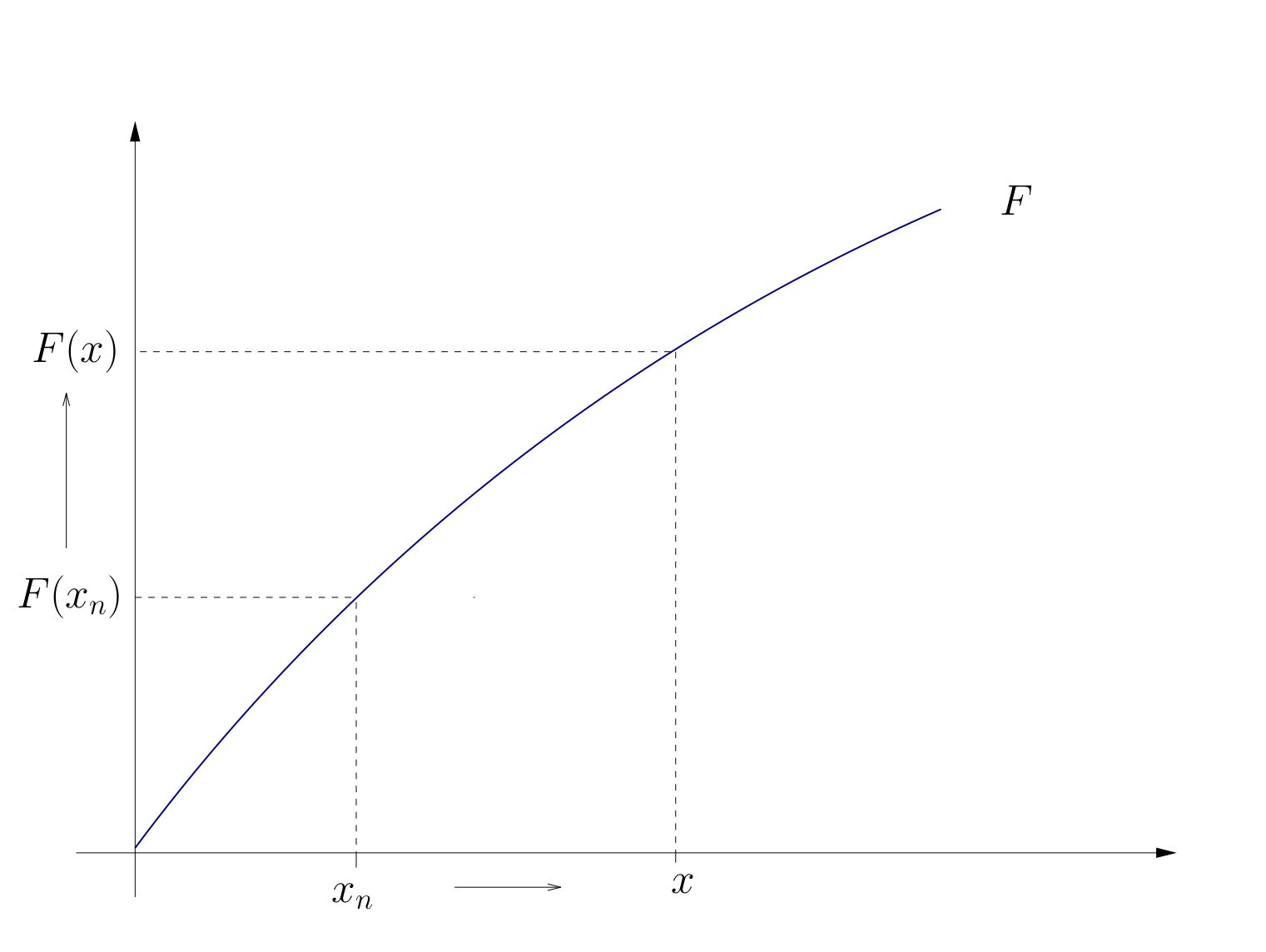
Fig. 37 Continuous function#
Example
Function \(f(x) = \exp(x)\) is continuous at \(x=0\)
Proof:
Consider any sequence \(\{x_n\}\) which converges to \(0\)
We want to show that for any \(\epsilon>0\) there exists \(N\) such that \(n \geq N \implies |f(x_n) - f(0)| < \epsilon\). We have
Because due to \(x_n \to x\) for any \(\epsilon' = \ln(1-\epsilon)\) there exists \(N\) such that \(n \geq N \implies |x_n - 0| < \epsilon'\), we have \(f(x_n) \to f(x)\) by definition. Thus, \(f\) is continuous at \(x=0\).
Fact
Some functions known to be continuous on their domains:
\(f: x \mapsto x^\alpha\)
\(f: x \mapsto |x|\)
\(f: x \mapsto \log(x)\)
\(f: x \mapsto \exp(x)\)
\(f: x \mapsto \sin(x)\)
\(f: x \mapsto \cos(x)\)
Types of discontinuities#
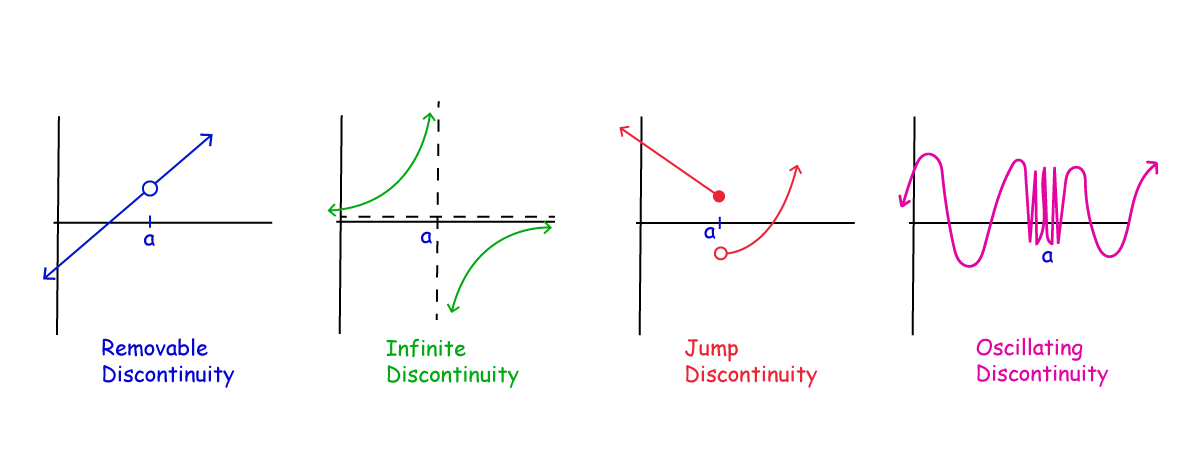
Fig. 38 4 common types of discontinuity#
Example
The indicator function \(x \mapsto \mathbb{1}\{x > 0\}\) has a jump discontinuity at \(0\).
Fact
Let \(f\) and \(g\) be functions and let \(\alpha \in \mathbb{R}\)
If \(f\) and \(g\) are continuous at \(x\) then so is \(f + g\), where
If \(f\) is continuous at \(x\) then so is \(\alpha f\), where
If \(f\) and \(g\) are continuous at \(x\) and real valued then so is \(f \circ g\), where
In the latter case, if in addition \(g(x) \ne 0\), then \(f/g\) is also continuous.
Proof
Just repeatedly apply the properties of the limits
Let’s just check that
Let \(f\) and \(g\) be continuous at \(x\)
Pick any \(x_n \to x\)
We claim that \(f(x_n) + g(x_n) \to f(x) + g(x)\)
By assumption, \(f(x_n) \to f(x)\) and \(g(x_n) \to g(x)\)
From this and the triangle inequality we get
As a result, set of continuous functions is “closed” under elementary arithmetic operations
Example
The function \(f \colon \mathbb{R} \to \mathbb{R}\) defined by
is continuous (we just have to be careful to ensure that denominator is not zero – which it is not for all \(x\in\mathbb{R}\))
Example
An example of oscillating discontinuity is the function \(f(x) = \sin(1/x)\) which is discontinuous at \(x=0\).
Weierstrass boundedness theorem#
Putting together all the above material to formulate a fundamental result which is essential for establishing the existence of maxima and minima of functions in the next section.
Definition
A function \(f\) is called bounded if its range is a bounded set.
Fact
Consider a continuous function \(f: X \subset \mathbb{R}^N \to \mathbb{R}\).
If \(X\) is compact, then \(f\) is bounded on \(X\).
Proof
Sketch of the proof:
Suppose that range of \(f\) denoted \(f(X)\) is not a bounded set
Then we can find a sequence \(\{x_n\}\) in \(X\) such \(\forall n\in\mathbb{N}\) there exists \(f(x_n)\) such that \(|f(n)|>n\).
Sequence \(\{x_n\}\) is bounded, so by Bolzano-Weierstrass theorem it has a convergent subsequence \(\{x_{n_k}\}\), where \(n_k\) is a subset of \(\mathbb{N}\) index by \(k\), and thus \(k \leqslant n_k\) for all \(k\)
Denote by \(L\) the limit of this subsequence, \(L = \lim_{k \to \infty} \{x_{n_k}\}\)
\(L \in X\) because \(X\) is a compact and thus is a closed set
By continuity of \(f\) at \(L\) we have that \(f(x_{n_k}) \to f(L)\)
Then the sequence \(\{f(x_{n_k})\}\) is bounded due to the properties of the limit (see above)
This contradicts that by our construction \(|f(x_n)| > n \geqslant k\) where \(k\) can be arbitrary large
Also see the discussion here
Notes from the lecture#
References and further reading#
References
Simon & Blume: 12.1, 12.2, 12.3, 12.4, 12.5 10.1, 10.2, 10.3, 10.4, 13.4
Sundaram: 1.1.1, 1.1.2, 1.2.1, 1.2.2, 1.2.3, 1.2.7, 1.2.8, 1.4.1
Further reading and self-learning
Watch excellent video by Grant Sanderson (3blue1brown) on limits, and continue onto his whole amazing series on calculus
